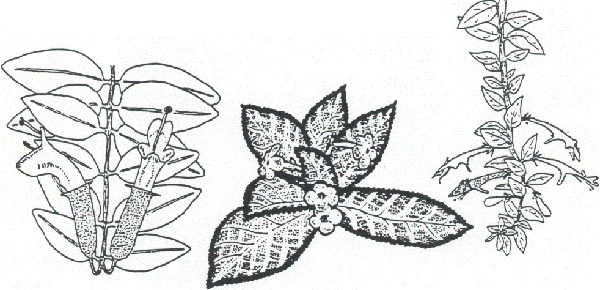Family Description
The Gesneriaceae are a diverse group of terrestrial (growing on the ground) or trailing epiphytic herbs or subshrubs from the Old World Tropics. It contains 140 genera and 1800 species. Plants are mostly pubescent but sometimes glabrous. Leaves are simple, with arrangement opposite or whorled in a basal rosette. Leaves and stems are often tinged with traces of purple pigmentation. Blooms are borne singly or in cymes or racemes. Flowers are 5-merous with petals usually united into tube, sometimes with a distinct two lipped arrangement. The most common member of this family, the African Violet (Saintpaulia ionantha), is atypical in that its petals are rotate with the tube so short it appears non¬existent. Stamens are 2-5 with the filaments often retracting the anthers after pollen is shed. The fruit is a capsule or sometimes a berry.
- Key diagnostic features of this family include:
- usually pubescent, purple tinted leaves
- tubular, bilabiate (two lipped) flowers
Gesneriads are popular flowering houseplants and potted florist plants. They grow best in organic, well drained, fertile soil in areas with filtered light. Cold water causes serious foliage problems. Propagation is by terminal cuttings, leaf cuttings and seed. Pests include mealybugs and mites.
Gesneriads in cultivation include x Achimenantha, Achimenes, Aeschynanthus, Agalmyla, Asteranthera, Boea, Capanea, Chirita, Chrysothemis, Codonanthe, Columnea, Conandron, Diastema, Drymonia, Episcia, Gesneria, x Gloxiantha, Gloxinia, Haberlea, Jankaea, Lysionotus, Mitraria, Nematanthus, Niphaea, Paradrymonia, Petrocosmea, Phinaea, Ramonda, Rehmannia, Saintpaulia, Sarmienta, Sinningia, Smithiantha, and Streptocarpus.

Aeschynanthus radicans (left), Episcia cupreata (center), and Columnea tulae (right). Note bilabiate flowers on Aeschynanthus and Columnea.
Representative Species
click thumbnail to enlarge |
|||||||
| * | Saintpaulia ionantha | African Violet |
|
||||
| * | Sinningia speciosa | Gloxinia |
|

